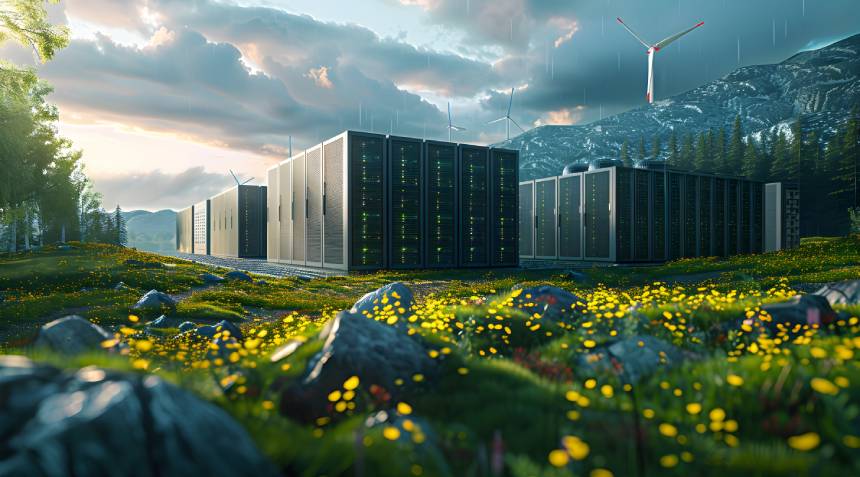Sustainable Energy Practices in Data Centers: Going Green
Data center industry has experienced rapid growth due to the increasing demand for cloud computing, artificial intelligence, and the overall digital transformation of businesses worldwide. However, this exponential growth comes with a significant environmental impact. Data centers are responsible for a substantial portion of global energy consumption, and as such, their environmental footprint is a growing concern.
As the demand for data storage and processing power rises, data centers are being called upon to adopt sustainable energy practices that minimize their environmental impact. Sustainable energy practices not only help reduce carbon emissions but also contribute to the long-term viability and resilience of the industry.
Environmental Impacts of Data Center Energy Consumption
Data centers are energy-intensive facilities, with their operations typically requiring a constant supply of power to run servers, store data, and manage various applications. A key concern is the sheer volume of energy consumed by these facilities, which has a direct impact on the environment.
- High Energy Demands and Carbon Emissions: According to recent studies, data centers account for approximately 1% of global energy consumption, a percentage that continues to grow as the demand for digital services increases. This energy consumption often relies heavily on non-renewable sources, contributing to greenhouse gas emissions and climate change.
- Local Ecosystems and Environmental Footprint: Data centers are often located in regions where access to electricity is abundant, but these facilities can strain local energy grids, especially during peak demand periods. Additionally, traditional data center cooling methods, such as air conditioning, consume vast amounts of power, further exacerbating environmental concerns.
- Trends in Data Center Energy Consumption: As businesses continue to digitalize, energy consumption in data centers is projected to increase. This trend highlights the importance of adopting sustainable practices and finding ways to make data center operations more energy-efficient.
The Integration of Renewable Energy Sources
To address the growing environmental challenges associated with data center energy consumption, the integration of renewable energy sources has become a vital solution. By harnessing renewable energy, data centers can significantly reduce their reliance on non-renewable, carbon-intensive power sources.
Solar, Wind, and Hydroelectric Energy
Many data centers are shifting to solar and wind energy to power their operations. Solar panels can be installed on-site to generate clean energy, while wind turbines and hydroelectric power can be sourced from local grids or directly from renewable energy producers. By integrating these sustainable energy sources, data centers can lower their carbon footprint and reduce dependency on traditional fossil fuels.
Benefits of Renewable Energy Integration
- Reduced Carbon Emissions: Using renewable energy sources helps to significantly cut down the amount of CO2 emitted by data centers.
- Cost Savings: While the initial investment in renewable infrastructure may be high, it can lead to long-term cost savings through reduced energy bills and government incentives for using clean energy.
- Energy Independence: Data centers that use renewable energy sources are less reliant on external power suppliers, improving their energy security and ensuring a more stable energy supply.
Case Studies of Successful Adoption
- Many leading tech companies, including Google, Microsoft, and Amazon, have already made significant strides in powering their data centers with renewable energy. Google, for example, has been carbon-neutral since 2007 and runs its data centers on 100% renewable energy.

Best Practices for Energy-Efficient Data Centers
Energy efficiency is crucial in reducing the environmental impact of data centers. By adopting a combination of energy-saving technologies and operational strategies, businesses can optimize their infrastructure while minimizing energy consumption.
- Efficient Cooling Systems: Traditional air-conditioning systems consume large amounts of energy to cool servers. Modern data centers are now adopting more energy-efficient cooling solutions, such as liquid cooling and free-air cooling, which use less power and improve overall efficiency.
- Server and Infrastructure Optimization: Energy-efficient data centers make use of power-efficient servers and equipment that consume less electricity without sacrificing performance. Virtualization technologies also enable better resource utilization, reducing the need for additional physical servers.
- Advanced Monitoring and Automation: Using advanced monitoring tools, data centers can continuously track their energy consumption and identify areas where improvements can be made. Automation systems allow for the adjustment of power settings based on real-time demand, ensuring energy is not wasted.
- Energy Efficiency Certifications and Standards: Many data centers strive to meet energy efficiency certifications, such as LEED (Leadership in Energy and Environmental Design) and ENERGY STAR, which help organizations measure their environmental performance and promote sustainable practices.
Ixpanse Teknoloji’s Commitment to Sustainability and Green Initiatives
At Ixpanse Teknoloji, sustainability is at the heart of our operations. We are committed to adopting and promoting energy-efficient solutions in our business practices. Our green initiatives focus on reducing our carbon footprint and ensuring that our energy consumption aligns with environmental best practices.
- Use of Renewable Energy: We have integrated renewable energy sources, such as solar and wind power, into our data center operations. This commitment helps to reduce the impact of our energy consumption on the environment and contributes to our goal of achieving carbon neutrality.
- Energy-Efficient Infrastructure: Ixpanse Teknoloji has implemented state-of-the-art energy-efficient technologies, such as advanced cooling systems, power-efficient servers, and optimized data storage solutions, to minimize energy usage and ensure the highest levels of performance.
- Ongoing Sustainability Goals: Our future plans include further expanding our use of renewable energy, increasing the energy efficiency of our infrastructure, and reducing waste throughout our operations. We are also committed to continuously improving our sustainability practices to contribute to the long-term health of the planet.
The Future of Sustainable Data Centers
The data center industry is evolving rapidly, and as the demand for digital services grows, so does the need for sustainable energy practices. By integrating renewable energy sources, adopting energy-efficient technologies, and promoting green initiatives, data centers can significantly reduce their environmental impact and operate in a more eco-friendly manner.
The future of sustainable data centers is bright, and at Ixpanse Teknoloji, we are proud to be part of this movement towards a greener, more efficient digital future. We are dedicated to providing our clients with the best-in-class, energy-efficient solutions that not only support their business objectives but also help protect our planet.




